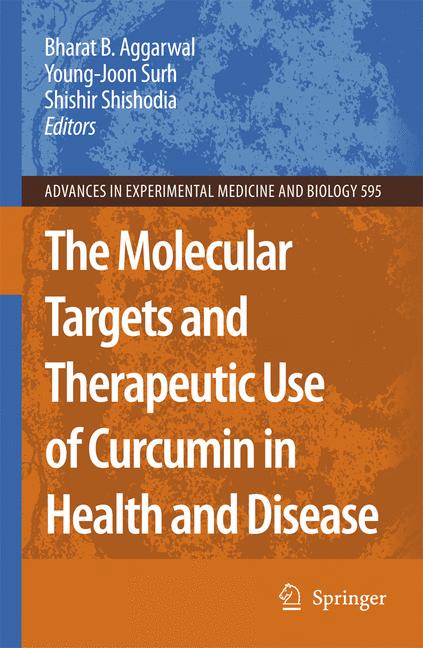| Chapter title |
Curcumin: the Indian solid gold.
|
|---|---|
| Chapter number | 1 |
| Book title |
The Molecular Targets and Therapeutic Uses of Curcumin in Health and Disease
|
| Published in |
Advances in experimental medicine and biology, June 2007
|
| DOI | 10.1007/978-0-387-46401-5_1 |
| Pubmed ID | |
| Book ISBNs |
978-0-387-46400-8, 978-0-387-46401-5
|
| Authors |
Aggarwal BB, Sundaram C, Malani N, Ichikawa H, Bharat B. Aggarwal, Chitra Sundaram, Nikita Malani, Haruyo Ichikawa, Aggarwal, Bharat B., Sundaram, Chitra, Malani, Nikita, Ichikawa, Haruyo |
| Editors |
Bharat B. Aggarwal Ph.D., Young-Joon Surh Ph.D., Shishir Shishodia Ph.D. |
| Abstract |
Turmeric, derived from the plant Curcuma longa, is a gold-colored spice commonly used in the Indian subcontinent, not only for health care but also for the preservation of food and as a yellow dye for textiles. Curcumin, which gives the yellow color to turmeric, was first isolated almost two centuries ago, and its structure as diferuloylmethane was determined in 1910. Since the time of Ayurveda (1900 Bc) numerous therapeutic activities have been assigned to turmeric for a wide variety of diseases and conditions, including those of the skin, pulmonary, and gastrointestinal systems, aches, pains, wounds, sprains, and liver disorders. Extensive research within the last half century has proven that most of these activities, once associated with turmeric, are due to curcumin. Curcumin has been shown to exhibit antioxidant, anti-inflammatory, antiviral, antibacterial, antifungal, and anticancer activities and thus has a potential against various malignant diseases, diabetes, allergies, arthritis, Alzheimer's disease, and other chronic illnesses. These effects are mediated through the regulation of various transcription factors, growth factors, inflammatory cytokines, protein kinases, and other enzymes. Curcumin exhibits activities similar to recently discovered tumor necrosis factor blockers (e.g., HUMIRA, REMICADE, and ENBREL), a vascular endothelial cell growth factor blocker (e.g., AVASTIN), human epidermal growth factor receptor blockers (e.g., ERBITUX, ERLOTINIB, and GEFTINIB), and a HER2 blocker (e.g., HERCEPTIN). Considering the recent scientific bandwagon that multitargeted therapy is better than monotargeted therapy for most diseases, curcumin can be considered an ideal "Spice for Life". |
X Demographics
Geographical breakdown
| Country | Count | As % |
|---|---|---|
| United States | 8 | 28% |
| Spain | 5 | 17% |
| India | 2 | 7% |
| Venezuela, Bolivarian Republic of | 1 | 3% |
| Australia | 1 | 3% |
| United Kingdom | 1 | 3% |
| Unknown | 11 | 38% |
Demographic breakdown
| Type | Count | As % |
|---|---|---|
| Members of the public | 24 | 83% |
| Practitioners (doctors, other healthcare professionals) | 4 | 14% |
| Scientists | 1 | 3% |
Mendeley readers
Geographical breakdown
| Country | Count | As % |
|---|---|---|
| India | 4 | <1% |
| United States | 3 | <1% |
| United Kingdom | 2 | <1% |
| Italy | 2 | <1% |
| Australia | 2 | <1% |
| Iran, Islamic Republic of | 2 | <1% |
| Indonesia | 1 | <1% |
| Egypt | 1 | <1% |
| Portugal | 1 | <1% |
| Other | 2 | <1% |
| Unknown | 785 | 98% |
Demographic breakdown
| Readers by professional status | Count | As % |
|---|---|---|
| Student > Ph. D. Student | 139 | 17% |
| Student > Bachelor | 117 | 15% |
| Student > Master | 115 | 14% |
| Researcher | 73 | 9% |
| Student > Doctoral Student | 54 | 7% |
| Other | 133 | 17% |
| Unknown | 174 | 22% |
| Readers by discipline | Count | As % |
|---|---|---|
| Agricultural and Biological Sciences | 140 | 17% |
| Medicine and Dentistry | 110 | 14% |
| Biochemistry, Genetics and Molecular Biology | 84 | 10% |
| Chemistry | 77 | 10% |
| Pharmacology, Toxicology and Pharmaceutical Science | 58 | 7% |
| Other | 113 | 14% |
| Unknown | 223 | 28% |
